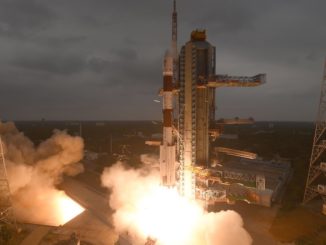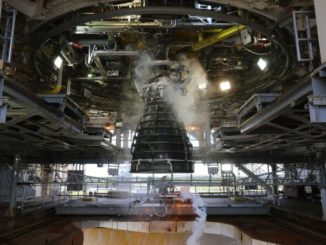EDITOR’S NOTE: Launch has been rescheduled for 9:13 p.m. EST on Nov. 24 (0213 GMT on Nov. 25).

Sixty more Starlink internet satellites are ready to rocket into orbit Sunday night from Cape Canaveral on the 100th flight of a SpaceX Falcon 9 launcher, and the seventh flight of SpaceX’s reusable “fleet leader” booster.
The Falcon 9 rocket is scheduled to launch at 9:56:21 p.m. EST Sunday (0256:21 GMT Monday) from pad 40 at Cape Canaveral Air Force Station. The mission is set to blast off less than 34 hours after SpaceX’s previous flight, a Falcon 9 launch from California that hauled into orbit an oceanography satellite designed to measure sea level rise.
The Falcon 9 launch with the Sentinel-6 Michael Freilich oceanography satellite Saturday was SpaceX’s 22nd mission of 2020, breaking the company’s record for the most launches it’s performed in a calendar year. Sunday’s flight will extend the record.
While the Falcon 9 launch from California flew with a factory-fresh first stage booster, SpaceX’s launch from Florida Sunday night will use a booster that’s flown six times before. The seventh flight of the rocket will set a new record for SpaceX’s rocket reuse program, breaking a mark set by the same booster on its sixth mission in August.
The rocket set for launch Sunday — known as B1049 — debuted in September 2018 with the launch of the Telstar 18 VANTAGE geostationary communications satellite from Cape Canaveral. It launched again from Vandenberg Air Force Base in California in January 2019 with 10 Iridium voice and data relay satellites.
The booster flew again in May 2019 with SpaceX’s first set of 60 Starlink internet satellites, followed by three more Starlink missions on Jan. 6, June 3, and Aug. 18.
“This launch will make it the fleet leader,” SpaceX tweeted of the booster Saturday.
Elon Musk, SpaceX’s founder and CEO, has said the newest version of the Falcon 9 booster could fly 10 times without any major refurbishment, and perhaps 100 times with periodic overhauls.
There is a 60 percent chance of favorable weather at Cape Canaveral for launch Sunday night, according to the U.S. Space Force’s 45th Weather Squadron. The chief weather concerns are with cumulus clouds and disturbed weather associated with scattered rain showers along Florida’s Space Coast.
SpaceX test-fired the rocket’s nine Merlin 1D engines at 4 p.m. EST (2100 GMT) Saturday. The engines ignited for several seconds while hold-down clamps kept the rocket firmly on pad 40, sending a low rumble across the Cape Canaveral spaceport.
The launch team originally planned to test-fire the rocket early Friday ahead of a potential launch attempt Saturday night, but SpaceX aborted the test in the final moments before ignition. After draining the propellant from the rocket, SpaceX refilled the Falcon 9 during a practice countdown Saturday afternoon, culminating in the success test-firing at 4 p.m.
SpaceX will load kerosene and liquid oxygen propellants into the rocket again Sunday evening beginning at 9:21 p.m. EST (0221 GMT). The automated countdown will proceed through propellant loading, final guidance system checkouts, and pressurization before issuing the command to ignite the nine Merlin 1D engines at T-minus 3 seconds.
Restraints will open to allow the 229-foot-tall (70-meter) Falcon 9 rocket to climb away from pad 40 with 1.7 million pounds of thrust from its Merlin main engines.
Heading northeast from Cape Canaveral, the rocket’s first stage booster will separate about two-and-a-half minutes into the mission, targeting a landing on SpaceX’s drone ship “Of Course I Still Love You” around 400 miles (650 kilometers) northeast of the launch site.
The booster is scheduled to land on the floating platform at T+plus 8 minute, 44 seconds, moments before shutdown of the Falcon 9’s upper stage engine. The upper stage will deploy the 60 flat-panel Starlink satellites at T+plus 14 minutes, 44 seconds, according to a mission timeline released by SpaceX.
The rocket will aim to place the satellites into an elliptical orbit ranging between 132 miles (213 kilometers) and 227 miles (366 kilometers), with an inclination of 53 degrees to the equator.
The quarter-ton satellites, built by SpaceX in Redmond, Washington, are expected to unfurl power-generating solar arrays and prime their krypton ion thrusters to begin raising their orbits to an operational altitude of 341 miles (550 kilometers), where they will join more than 800 other Starlink relay stations to beam broadband internet signals across most of the populated world.
With the launch Sunday, SpaceX will have deployed 955 Starlink satellites into orbit since May 2019.
SpaceX plans to operate an initial block of around 1,500 Starlink satellites in orbits 341 miles above Earth. The company, founded by billionaire Elon Musk, has regulatory approval from the Federal Communications Commission to eventually field a fleet of up to 12,000 small Starlink broadband stations operating in Ku-band, Ka-band, and V-band frequencies.
There are also preliminary plans for an even larger fleet of 30,000 additional Starlink satellites, but a network of that size has not been authorized by the FCC.
SpaceX says the Starlink network — designed for low-latency internet service — has entered a beta testing phase in multiple U.S. states and Canada.
“Last month, SpaceX launched its “Better Than Nothing Beta” test program,” the company said in a post on its website. “Service invites were sent to a portion of those who requested availability updates on Starlink.com and who live in serviceable areas. A couple weeks ago, Canada granted Starlink regulatory approval and last week SpaceX rolled out the service to parts of parts of southern Canada.”
Email the author.
Follow Stephen Clark on Twitter: @StephenClark1.



